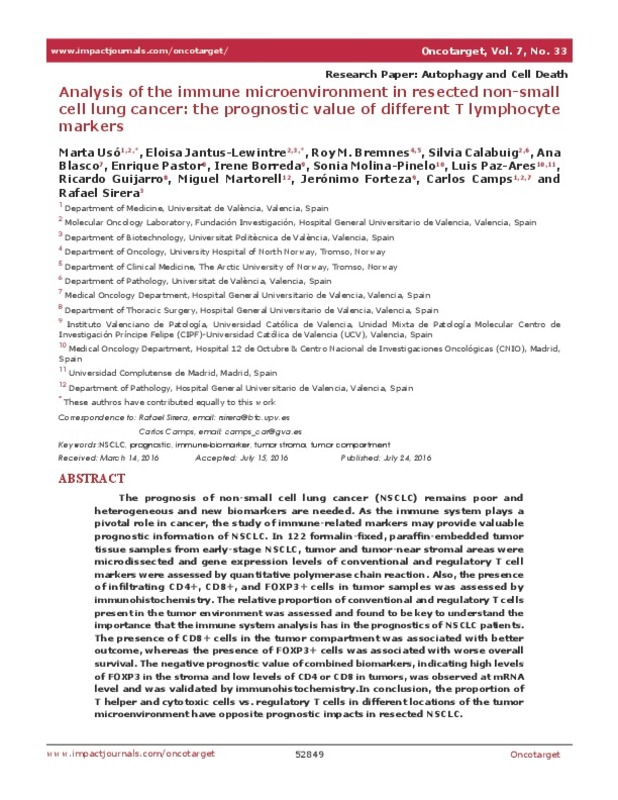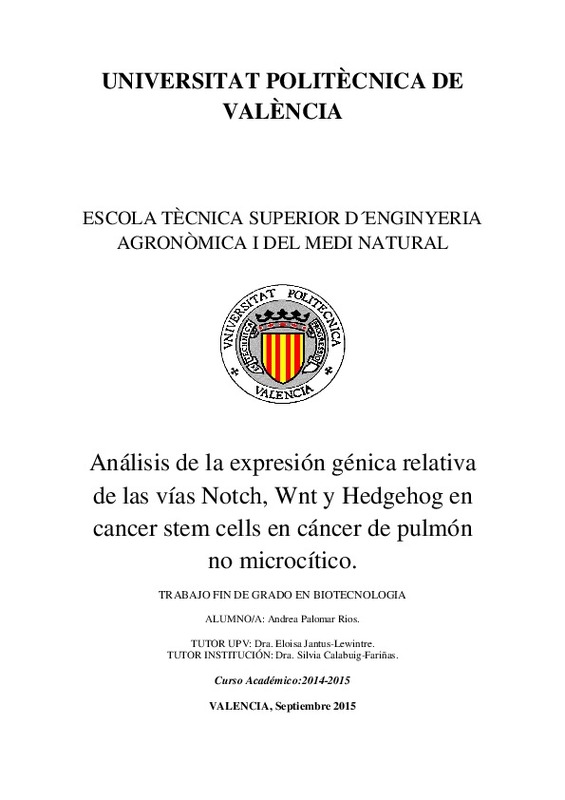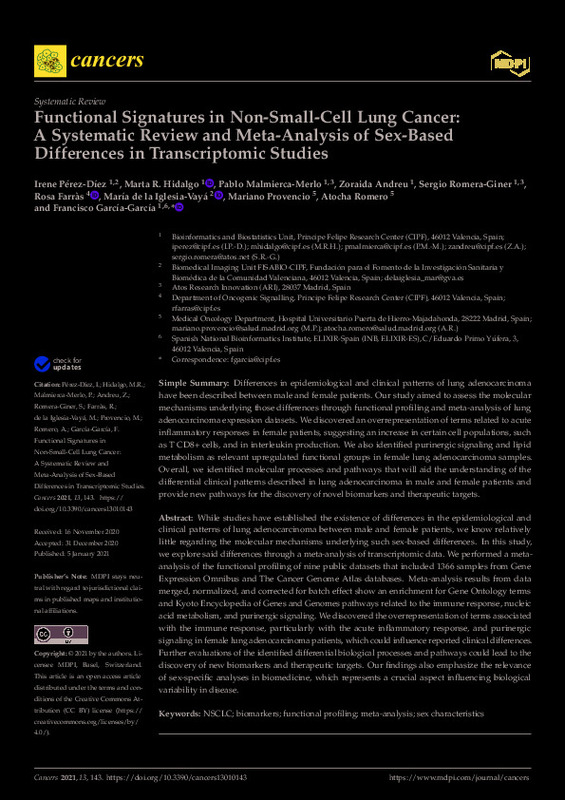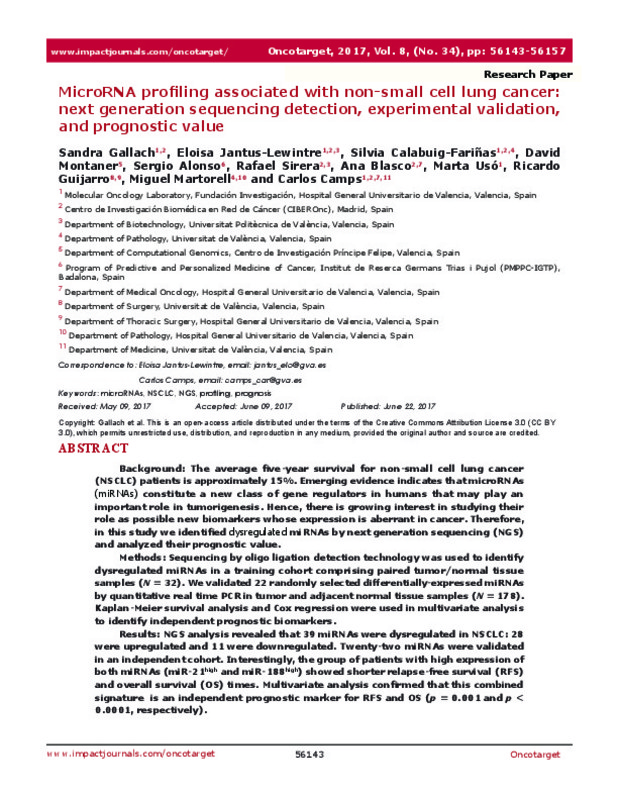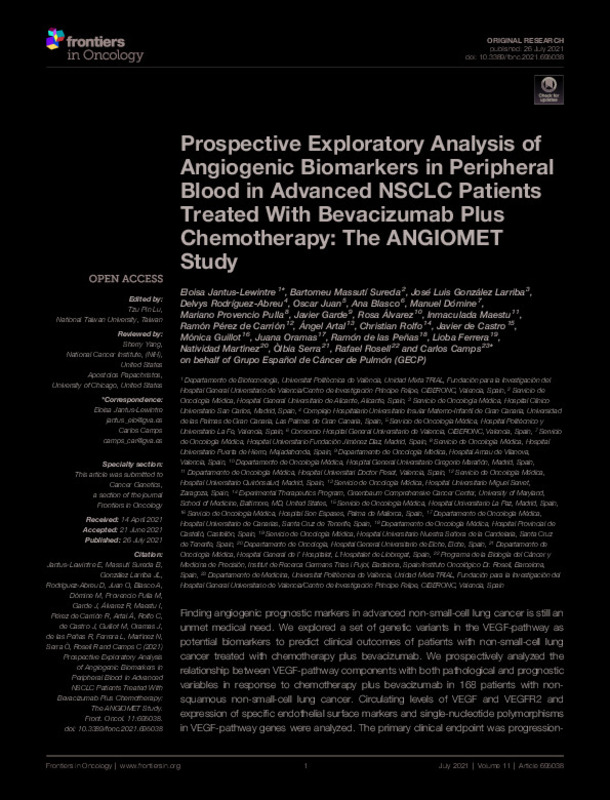

Listar por palabra clave "NSCLC"
RiuNet: Repositorio Institucional de la Universidad Politécnica de Valencia
- RiuNet repositorio UPV
- :
- Listar por palabra clave
JavaScript is disabled for your browser. Some features of this site may not work without it.
Buscar en RiuNet
Listar
Mi cuenta
Ayuda RiuNet
Admin. UPV
Listar por palabra clave "NSCLC"
Mostrando ítems 1-17 de 17
-
Usó Marco, Marta (Universitat Politècnica de València, 2015-06-05)[EN] Lung cancer is the leading cause of cancer-related death worldwide, and is the third most common cancer type; it can be classified into two subgroups based on histology: non-small-cell lung cancer (NSCLC) and small-cell ...
-
Usó-Marco, Marta; Jantus-Lewintre, Eloisa; Bremnes, Roy M.; Calabuig-Fariñas, Silvia; Blasco-Cordellat, Ana; Pastor, Enrique; Borreda, Irene; Molina-Pinelo, Sonia; Paz-Ares, Luis; Guijarro, Ricardo; Martorell, Miguel; Forteza, Jerónimo; Camps-Herrero, Carlos; Sirera Pérez, Rafael (Impact Journals, LLC, 2016-08-16)[EN] The prognosis of non-small cell lung cancer (NSCLC) remains poor and heterogeneous and new biomarkers are needed. As the immune system plays a pivotal role in cancer, the study of immune-related markers may provide ...
-
Usó, Marta; Jantus-Lewintre, Eloisa; Calabuig-Farinas, Silvia; Blasco, Ana; Garcia del Olmo, Eva; Guijarro, Ricardo; Martorell, Miguel; Camps, Carlos; Sirera Pérez, Rafael (Taylor & Francis, 2017)[EN] Tumors develop mechanisms to recruit tolerogenic immune cells and to induce the expression of molecules that act as immune checkpoints. This regulation of the immune microenvironment favors immune tolerance to the ...
-
Jantus Lewintre, Eloisa; Sirera Pérez, Rafael; Cabrera, Andrea; Blasco, Ana; Caballero, Cristina; Iranzo, Vega; Rosell, Rafael; Camps, Carlos (Elsevier, 2011-09)[EN] Background: Epidermal growth factor receptor (EGFR) is overexpressed in a variety of epithelial malignancies including lung cancer. A soluble fragment of the EGFR extracellular domain (sEGFR) can be detected in the ...
-
Pérez Marcos, Juan José (Universitat Politècnica de València, 2014-09-26)[EN] Regulatory T ymphocytes (Tregs) play a critical role in immune tolerance to tumor cells. Several molecules, including CD127, CD25, CTLA-4, IL-10, LAG3, GITR, TNFα, CD4, CD8 y TGFβ-1have been reported markers of ...
-
Palomar Rios, Andrea (Universitat Politècnica de València, 2015-10-20)[ES] En Cáncer de Pulmón, la supervivencia global no supera el 15% a los cinco años. Incluso disponiendo de terapias individualizadas, la adquisición de resistencias a los tratamientos es una de las causas principales de ...
-
Sirera Pérez, Rafael (Elsevier, 2011-07)[EN] Background: Platinum doublets are standard chemotherapy for advanced non-small-cell lung cancer (NSCLC). The aim of this study was to assess whether neutropenia is: (1) an indicator for treatment efficacy, or (2) ...
-
Circulating DNA is a useful prognostic factor in patients with advanced non-small cell lung cancer Sirera Pérez, Rafael; Bremnes, Roy M.; Cabrera, Andrea; Jantus Lewintre, Eloisa; Sanmartin, Elena; Blasco, Ana; del Pozo, Nieves; Rosell, Rafael; Guijarro, Ricardo; Galbis, Jose; Sanchez, Jose Javier; Camps, Carlos (Lippincott, Williams & Wilkins, 2011-02)Background: Circulating DNA is observed at higher concentrations in patients with lung cancer than in controls. Qualitative and quantitative analysis of circulating DNA is a promising noninvasive tool. Our aim was to ...
-
Alarcón Ruiz, Iván (Universitat Politècnica de València, 2020-09-15)[ES] La biología sintética busca aplicar los principios de la ingeniería a los organismos vivos, con el objetivo de controlar y modular su comportamiento. Esta disciplina ha permitido el diseño y construcción de circuitos ...
-
Antón Salvador, Javier (Universitat Politècnica de València, 2024-10-14)[ES] El cáncer es un grupo heterogéneo de enfermedades cuya incidencia está en aumento y el cual se espera que constituya la principal causa de muerte del siglo XXI. El cáncer de pulmón es el tipo más frecuente de cáncer, ...
-
Pérez-Díez, Irene; Hidalgo, Marta R.; Malmierca-Merlo, Pablo; Andreu, Zoraida; Romera-Giner, Sergio; Farràs, Rosa; De la Iglesia-Vayá, María; Provencio, Mariano; Romero, Atocha; García-García, Francisco (MDPI AG, 2021-01)[EN] While studies have established the existence of differences in the epidemiological and clinical patterns of lung adenocarcinoma between male and female patients, we know relatively little regarding the molecular ...
-
Gallach-Garcia, Sandra; Jantus-Lewintre, Eloisa; Calabuig-Fariñas, Silvia; Montaner, David; Alonso, Sergio; Sirera Pérez, Rafael; Blasco, Ana; Usó-Marco, Marta; Guijarro, Ricardo; Martorell, Miguel; Camps-Herrero, Carlos (Impact Journals, LLC, 2017-06-22)[EN] Background: The average five-year survival for non-small cell lung cancer (NSCLC) patients is approximately 15%. Emerging evidence indicates that microRNAs (miRNAs) constitute a new class of gene regulators in humans ...
-
Moreno Manuel, Andrea (Universitat Politècnica de València, 2025-04-22)[ES] El cáncer de pulmón no microcítico (CPNM) representa un 80% de los casos de cáncer de pulmón, siendo uno de los tipos de cáncer más frecuentes y mortales. El tratamiento con inmunoterapia ha mejorado significativamente ...
-
Soto Ruiz de la Torre, Mar (Universitat Politècnica de València, 2016-01-07)[EN] Angiogenesis plays a main role in tumor development. Host genetic variability in genes related to that process, such as VEGFA, VEGFR-1 and VEGFR-2, could affect patient’s therapy and prognostic. The goal of this ...
-
Jantus-Lewintre, Eloisa; Massuti Sureda, Bartomeu; Gonzalez Larriba, Jose Luis; Rodríguez-Abreu, Delvys; Juan, Oscar; Blasco, Ana; Domine, Manuel; Provencio Pulla, Mariano; Garde, Javier; Alvarez, Rosa; Maestu, Inmaculada; Perez de Carrion, Ramon; Artal, Angel; Rolfo, Christian; de Castro, Javier; Camps, Carlos (Frontiers Media SA, 2021-07-26)[EN] Finding angiogenic prognostic markers in advanced non-small-cell lung cancer is still an unmet medical need. We explored a set of genetic variants in the VEGF-pathway as potential biomarkers to predict clinical outcomes ...
-
Bremnes, Roy M.; Donnem, Tom; Al-Saad, Samer; Al-Shibli, Khalid; Andersen, Sigve; Sirera Pérez, Rafael; Camps, Carlos; Marinez, Inigo; Busund, Lill-Tove (Lippincott, Williams & Wilkins, 2011-01)[EN] Maintenance of both normal epithelial tissues and their malignant counterparts is supported by the host tissue stroma. The tumor stroma mainly consists of the basement membrane, fibroblasts, extracellular matrix, ...
-
Bremnes, Roy M.; Al-Shibli, Khalid; Donnem, Tom; Sirera Pérez, Rafael; Al-Saad, Samer; Andersen, Sigve; Stenvold, Helge; Camps, Carlos; Busund, Lill-Tove (Lippincott, Williams & Wilkins, 2011-04)[EN] In addition to malignant neoplastic cells, cancer tissues also include immune cells, fibroblasts, and endothelial cells, including an abundant collection of growth factors, proangiogenic mediators, cytokines, chemokines, ...
Mostrando ítems 1-17 de 17

Universitat Politècnica de València. Unidad de Documentación Científica de la Biblioteca (+34) 96 387 70 85 · RiuNet@bib.upv.es



